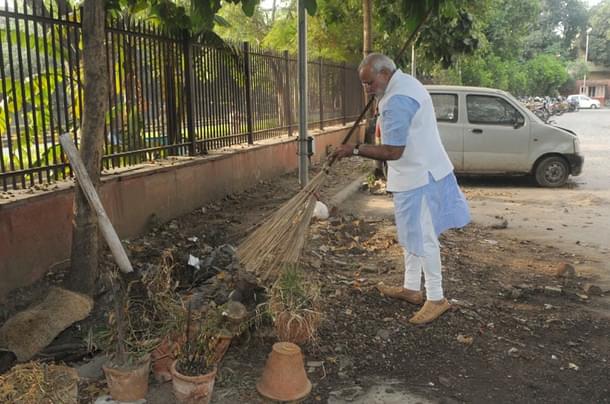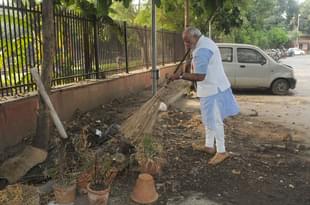Politics
Swachh Bharat Mission: More Than What You See In This Report
Aravindan Neelakandan
Sep 14, 2024, 08:41 AM | Updated Sep 15, 2024, 11:38 AM IST
Save & read from anywhere!
Bookmark stories for easy access on any device or the Swarajya app.


The Swachh Bharat Mission (SBM), launched by the Government of India in 2014, is said to be a programme close to the heart of Prime Minister Narendra Modi. Under this, building toilets and freeing India of open defecation became a national mission.
Between 2014 to 2020, 10 crore and 40 lakh toilets had been constructed across 60,000 villages making them free of open defecation.
But how effective has SBM really been?
Rahul Gandhi, who is now the leader of the opposition in Indian Parliament, ridiculed the mission openly. In 2015, soon after the launch of the mission, Gandhi was interacting with the students of the prestigious Mount Carmel College for women in Bengaluru and made a swipe at the SBM, rhetorically asking how cleaning the nation could be a strategic national programme and said it had failed anyway. Interestingly, the college students responded with overwhelming support for the mission.
How correct was the assessment of Rahul Gandhi? And how right were the students of Mount Carmel College in placing their faith in the success and relevance of SBM?
A study has been done by researchers from International Food Policy Research Institute (IFPRI), University of California and The Ohio State University on the effect of SBM. They analysed data from 35 Indian states and 640 districts spanning 10 years. The chosen decade of the study, 2011-2020, included both pre-SBM and post-SBM periods. They mapped ‘changes in Infant Mortality Rate (IMR) and Under 5 Mortality Rate (U5MR) and toilet access at the district level over time.’
The results have been published in Nature’s Scientific Reports journal.
The researchers say:
Toilet access and child mortality have a historically robust inverse association in India. Toilets constructed increased dramatically across India following the implementation of SBM in 2014…. The post-SBM period in India exhibited accelerated reductions in infant and child mortality compared to the pre-SBM years. Based on our regression estimates, the provision of toilets at-scale may have contributed to averting approximately 60,000–70,000 infant deaths annually. Our findings show that the implementation of transformative sanitation programs can deliver population health benefits in low- and middle-income countries.
Quite significantly SBM has been designed and implemented with the awareness of its importance for child welfare in India. It is the children from the marginalised and economically deprived sections of the society that are at the heart of SBM.
Dr. Jayanti Ravi, a physicist-turned-IAS officer was earlier the Principal Secretary and Commissioner of Rural Development in Gujarat and later of the Health and Family Welfare department. In her book, Sanity in Sanitation, (Penguin, 2019), Dr.Ravi points out the intricate web connecting open defecation, disease and child mortality:
According to a UNICEF report, one gram of faeces contains 10,000,000 viruses, 1,000,000 bacteria, 1,000 parasite cysts, and 100 worm eggs! … In 2015, fatal diarrhoea caused close to 104,6435 deaths among children under the age of five in India. In villages, a vast majority of the population still does not wear footwear, and in the case of children, it is considered an unnecessary luxury…. Children, the most vulnerable of this group are the prime victims of diseases such as cholera, malnutrition, polio among others caused by exposure to bacteria such as hookworm from walking barefoot in these areas…. MH3706 disappearing is news even today but why doesn’t the death tally of over 104,643 children and more not turning up at school, work, after a disease or illness afflicts them, not shake us up? The high death rate among children under the age of five years is alarming, but what is equally sad are the opportunities many children lose as they are unable to attend school because they are unwell due to illnesses that could have been easily prevented with healthy sanitation practices.p.52
One should remember that these words were written in 2019, five years before the current study.
The study demonstrates that the mission has had a positive impact on children's health and has saved the lives of lakhs of kids. The study highlights how SBM significantly accelerated the decline in the infant mortality rate (IMR).
IMR exhibited an annual decline of three percent between 2000 and 2015. Furthermore, the post-SBM period witnessed a mean IMR that was ten percent lower compared to the pre-SBM period. Remarkably, the rate of IMR reduction in the post-SBM period was eight to nine percent per year higher than the pre-SBM rate of reduction.
This is no small achievement. The book, Sanity in Sanitation, shows the kind of dangers that the implementing of the mission faced – from community relations to religious beliefs.
A reading of the chapter on SBM implementation in Porbandar reveals the dedication, zeal, emotional intelligence, and strategic administrative abilities required to make the mission a success. This is just one told story. If we imagine the countless untold stories from SBM’s execution across 60,000 villages, we can begin to grasp the immense efforts behind achieving these results.
One should also remember that the Nature magazine published quite a biased op-ed story against the government of Narendra Modi, and during the election campaign at that. One can read all about it here. Hence, Nature’s Scientific Reports publishing this empirical data-based recognition of the accomplishment of SBM, acquires even more significance.
Yes, the students of Mount Carmel College, who, in the face of a high voltage speaker, stood their ground and reposed their faith in SBM, stand vindicated today.
--The paper, 'Toilet construction under the Swachh Bharat Mission and infant mortality in India', by Chakrabarti, S., Gune, S., Bruckner, T.A. et al. is available here.
-Amazon link for 'Sanity in Sanitation' here.





